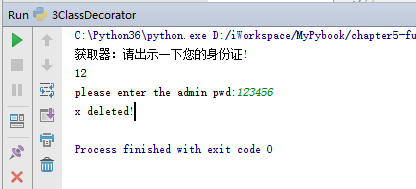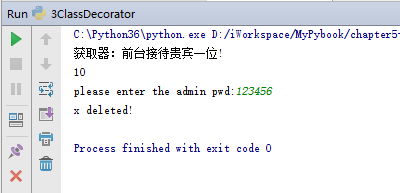@ overview
- The function of property decorator is to integrate all kinds of property accessors (setx, getx,delx) into one to help us lazy
- The original c.setx(value) is simplified to c.x = value with decorator
- The original print(c.getx()) is simplified to print(c.x) with decorator
- The original c.del x () is simplified to del c.x after adding a decorator
- The function of property accessor is to ensure data security. For unclear information, please refer to Property accessor and data security
Property is a class provided by the standard library. A property instance maps a common class property. When creating a property, we can specify various accessors for its corresponding property. Here is a revision of the official example
# An improved version of the official source code case
class C(object):
# Accessor (we can set the corresponding access right here, etc.)
def getx(self):
print("Accessor: please show me your ID card!")
return self.__x
# Setter (we can verify the validity of data here, etc.)
def setx(self, value):
# Here, the value of x must be greater than 0, otherwise an exception will be thrown
if value < 0:
raise ValueError("a positive x required")
self.__x = value
# Remover (we can set the corresponding access rights here)
def delx(self):
# You must enter the correct password to delete
pwd = input("please enter the admin pwd:")
if pwd == "123456":
del self.__x
print("x deleted!")
else:
print("Wrong password, fuck off!")
# How to create a property instance, declare the property and its various "devices"
x = property(fget=getx, fset=setx, fdel=delx, doc="I'm the 'x' property.")Now the usual getx,setx,delx of the \
# Test properties set as property instances
c = C()
c.x = 12 # setx
print(c.x) # getx
del c.x # Call delx
# print(c.x) # Report AttributeError to prove the deletion is successfulresults of enforcement 
We can also define the accessor more simply and intuitively through the property decorator. The above case can be rewritten as
# An improved version of the official source code case
# In the way of property decorator, declare property and its various "devices"
class C2(object):
# Property declaration can be used as an accessor when there is no accessor
@property
def x(self):
return self.__x
# Accessor (we can set the corresponding access right here, etc.)
@x.getter
def x(self):
"I'm the 'x' getter."
print("Accessor: Reception VIP at the front desk!")
return self.__x
# Setter (we can verify the validity of data here, etc.)
@x.setter
def x(self, value):
# Here, the value of x must be greater than 0, otherwise an exception will be thrown
if value < 0:
raise ValueError("a positive x required")
self.__x = value
# Remover (we can set the corresponding access rights here)
@x.deleter
def x(self):
# You must enter the correct password to delete
pwd = input("please enter the admin pwd:")
if pwd == "123456":
del self.__x
print("x deleted!")
else:
print("fuck off!")
The setting, obtaining and deleting of the \\\\\\\\\\
# Using the decorator version
c2 = C2()
# c2.x = -10 # ValueError: a positive x required
c2.x = 10 # Call the function decorated by x.setter
print(c2.x) # Call the function decorated by x.getter
del c2.x # Call the function decorated by x.delete
# print(c2.x) # Report AttributeError to prove the deletion is successfulresults of enforcement 